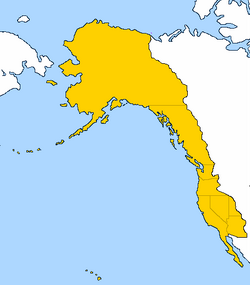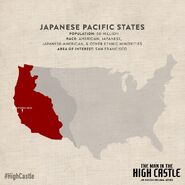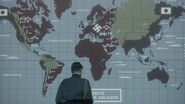|
Japanese Pacific States | ||||
| Three Pearls of the East
(Formerly) | ||||
| ||||

|

| |||
| Motto National Unity is our Virtue | ||||
| Anthem Kimigayo
| ||||
| Capital | San Francisco | |||
| Continent | North America | |||
| Government | Occupation Regime under an Imperial Authoritarian-Totalitarian Fascist System
(formerly) | |||
| Head of State and Government | Hirohito (formerly) (Emperor of Japan) Governor-General Yamori (1947-1964)[1][2][3] Governor-General Inokuchi (1964) | |||
| History | ||||
| - 1947 | Formed after the partition of the United States | |||
| - VA Day | World War II | |||
| - 1964 | Captured and liquidated by the Black Communist Rebellion | |||
| Population | 50 million (1962) | |||
| Currency | Japanese Yen | |||
| Official Language | English Japanese | |||
| Military | Imperial Japanese Army Navy (formerly) | |||
| Police | Kempeitai (formerly) | |||
| Western States
| ||||
The Japanese Pacific States (JPS) was the portion of the western United States of America and Canada that was occupied and administered as part of the Japanese Empire. It had been continuously under occupation since the end of the Second World War, after the capitulation of the United States government following the Greater Germen Reich's nuclear attack on Washington, D.C. in 1945 with a Heisenberg Device. After cementing total victory two years later by quelling the American Resistance, the Japanese Empire and the Greater Germen Reich partitioned the United States into three areas: the Pacific States of America in the Japanese sphere of influence, Nazi America in the German Reich, and a Neutral Zone separating the two superpowers.
After facing attacks from both the Black Communist Rebellion and Chinese forces, the Japanese withdrew from the Pacific States in 1964 to combat China. Since the withdrawal, the territory becomes a proto-state, known as the Western States, controlled by the BCR.
Overview[]
Territory[]
The Pacific States territory encompasses the western portion of the North American continent, stretching from Arizona in the south, to Alaska Territory in the north. The Pacific States are bounded by the Neutral Zone on its eastern border. Outside of San Francisco, other locations of note that still appear to be active in the territory include San Diego, Chula Vista, Carlsbad, Riverside, Irvine, Oceanside, Salinas, Long Beach, Sacramento, Seattle, Los Angeles, Santa Monica, Portland, Phoenix, Tucson, Flagstaff, Scottsdale, and Vancouver.
Flags and Emblems[]
The official flag of the Pacific States greatly resembles the Naval Ensign of Rising Sun Flag. A red sun-disc is off-set on a white field, with 12 blue rays of sun, and 8 red stars. The colors of the flag evoke the flag of the former United States, with the 8 stars representing the 6 former American states, one U.S. territory, and Canadian provinces and territories that comprise the Pacific States - Alaska Territory, Arizona, British Columbia, California, Nevada, Oregon, Utah and Washington. Hawaii was directly annexed into the Empire as an Overseas Territory. The flag was created by Admiral Isoroku Yamamoto, who resided in the country until his death.
Politics and Policies[]
The Pacific States' official capital is San Francisco, but the country is ruled indirectly from the Japanese capital Tokyo, possibly through membership of the Greater Co-Prosperity Sphere. Before 1947, the Japanese Pacific States' population consisted mostly of Caucasians and Japanese immigrants. Following Japan's invasion, several immigration policies were implemented, encouraging ethnic Japanese from Japan to migrate to the new colony. While Caucasians are still present in the country and the Japanese tolerate the presence of African-Americans and Jews, their racial policies are in line with those of the Greater Nazi Reich, favoring Japanese culture and people. The extent of racism in the Pacific States is mostly limited to ethnic Japanese enjoying higher standards of living, a majority of the country's police and military being composed of Japanese people, and ethnic Japanese holding larger economic and political weight in the country.
The Japanese Pacific States also the Japanese Empire's Kempeitai to have free reign. While not as extreme as the Nazi SS, the Kempeitai are still a ruthless force, employing psychological and physical torture as means of interrogation, as well as random executions of civilians in retaliation for Resistance attacks. Like in the Reich, Bibles are forbidden in the Pacific States. The official languages of the Japanese Pacific States are English and Japanese, however, the use of Japanese is not mandatory.
Economics and Technology[]
The economy of the Pacific States is closely tied to that of the Japanese Empire. Due to being in the Greater Co-Prosperity Sphere, the national currency is the Japanese Yen.
Japanese Withdrawal[]
After the Black Communist Rebellion blow up the critical infrastructure of the Pacific States, including the Crimson pipeline and several oil tankers; the Japanese Empire enters an oil shortage and were unable to supply oil to their troops handling resistance movements in Australia, China and India.
Under the Crown Princess' suggestion, Emperor Hirohito announces the immediate withdrawal of all Japanese citizens and military personnel from the Pacific States in October 1964. The official evacuation process was completed by November of that year, though clandestine trafficking was facilitated by the Yakuza well after the evacuation. After the withdrawal, American vigilantes form a lynch mob to kill any remaining Japanese citizens living in the Pacific States as a retaliation for the Japanese oppression and discrimination of the American people. They may also presumably plan to kill any Americans who are loyal to and collaborated with the Japanese. In the shows finale episode, it is revealed that Wehrmacht defectors from the GNR along with several senior Nazis are crossing over to the Western states as well.
Western States[]
The Western States is the successor proto-state of the Pacific States, led by a variety of resistance organizations including the American Resistance, BCR and Sabra. Threatened by Reichsfuhrer John Smith's Operation Fire Cross the Resistance and BCR are forced to bunker down and defend from the incoming invasion. It is unknown what happens to the Western States after John Smith's death. It’s possible that Bill Whitcroft became president and the western states rejoined the restored United States.
Gallery[]
References[]
- ↑ https://deadline.com/2018/10/the-man-in-the-high-castle-david-sakurai-carter-macintyre-bruce-locke-recur-season-4-1202492056/
- ↑ https://www.denofgeek.com/us/tv/the-man-in-the-high-castle/274465/the-man-in-the-high-castle-season-4-news
- ↑ http://vodzilla.co/blog/vod-news/amazon-renews-the-man-in-the-high-castle-for-season-3/







